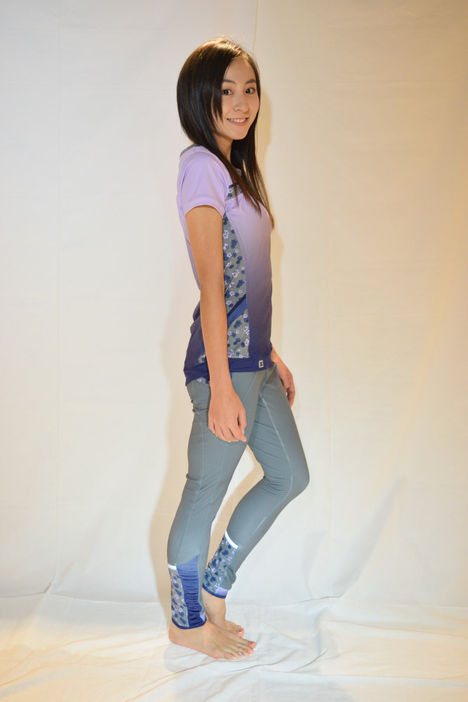Katherine West - Portfolio
Journeys in Sustainable Fashion & Contour Fashion:
Research, Design, Making, Retail & Display
Bespoke Project: with Baby Universe Inc, Japan

Across is the initial design and pattern development work carried out for Baby Universe Inc, to develop a collection of activewear garments that could be customised and personalised by the consumer through their Bespoke app, which can be downloaded on to a Smart Phone. Colours and pattern palettes were developed, designed to give a wide choice and to work well with the garment designs, created for cycling, running, yoga and general fitness activities. For the prototype outfit, a Polyester Elastane fabric was selected and the garment designs were developed to give good fit, be comfortable and easy to move in, to allow the wearer to benefit from the fabric's wicking properties, to be washable at low temperatures and for the high quality, durable print finish that can be achieved. The collection is designed to be produced in the same fabric, but depending on the garment, it will either be in a light, mid or heavier weight. In the case of this prototype service, the factory in Japan would be holding the stock of these 3 weights of fabric (and the trims and components) and when the data for an order is received production would take place and the finished garment posted/delivered to the consumer.
The prototype Bespoke app service and its production and delivery processes have been designed to allow a sustainable approach, in terms of achieving local, 'in country' production and having minimal transportation impacts on the environment. The bespoke garment would be designed on the app and the garment pattern generation, printing, cutting and manufacturing processes would take place in one location, in the country that the consumer lives in.
Using the app, the consumer can choose to adapt sleeve, body and leg lengths and widths within a design, to give a personalised fit. Colours and patterns are then selected from the Colour & Print palette by the consumer, for the main body, panels and trims of the garment. All pattern, printing and cutting data is auto-generated and the production of the printed, constructed and finished garment can be turned around in 3 days. Baby Universe also print a QR code on to the garment, so that the consumer can share their co-designed garment with others. The approaches have the aim of enhancing the emotional and physical durability of the garment/outfit.

Above shows example pattern, colour and garment development and manufacturing planning. A prototype outfit was developed using the technology, with a fitted legging and a semi-fitted top, in a UK size 8. Overall the prototype process and finished garments worked very well, however on the day of the photoshoot, the Japanese model selected to represent a Size 8, actually had a body size and shape that was more petite than a UK size 8, so the top appears a little big on her and the leggings a little too long and not a snug fit. It was decided that more work would be done to adapt the pattern pieces and sizing, to work better for Japanese women's heights and body sizes and shapes. Following further evaluation it was decided that for the 'main body' areas of a design, for example the 'legs' of the fitted legging, that it may be better to use a dyed fabric rather than printing the colour on to the surface. This is because at the seams, the 'white' of the fabric under the printed colour is visible, when the fabric is stretched to fit.
A really positive aspect of the technology, is that it allows for the 'direction' or 'positioning' of the pattern to be controlled, allowing left and right pattern pieces to be mirrored and for pattern designs to be applied to the pattern pieces in the best way (most aesthetically pleasing way). Digital experimentation is possible to get the best look and positioning, without wasting fabric and inks. With this design, the diagonal or horizontal lines of the pattern can be positioned to give a flattering line to the body. Cutting pattern pieces out in the traditional way, from an 'all-over print' fabric, means that a lot of fabric is wasted when trying to lay the pattern pieces on and use the right part of the pattern design. This technology has the potential to greatly reduce waste.
In the prototype garments, they were made of a knitted fabric that was a blend of Polyester and Elastane. I was unsure about the recyclability of the fabric and sought to find out whether the small amount of wasted fabric at production and the post-consumer textile waste was suitable for fibre-to-fibre recycling in Japan, with Teijin. My findings suggested that only 100% Polyester garments/fabrics could be recycled in this way. Therefore my next step was to begin experimenting with fabric that was 100% Polyester, with a 4 way stretch (and not blended with Elastane). I wanted to see if the same garment designs could be made with this type of alternative fabric and if not, I planned to adapt the designs to work with this new fabric composition.





